BUSS 3082 Staffing: A Comparison of Job and Competency Analysis
VerifiedAdded on 2023/06/14
|20
|3538
|435
Report
AI Summary
This report provides a detailed analysis of job-oriented and competency-oriented approaches to job analysis, contrasting their methodologies, advantages, and disadvantages. It uses the role of a Fitness Director as a case study to illustrate the practical application of both approaches, including the creation of job descriptions and specifications. The report highlights the key differences in focus, with job-oriented analysis emphasizing specific tasks and responsibilities, while competency-oriented analysis centers on the skills and qualifications required for the role. The document also includes appendices with job descriptions, specifications, and task statements, offering a comprehensive overview for students studying staffing organizations. Desklib is a platform that provides all the necessary AI based study tools for students.
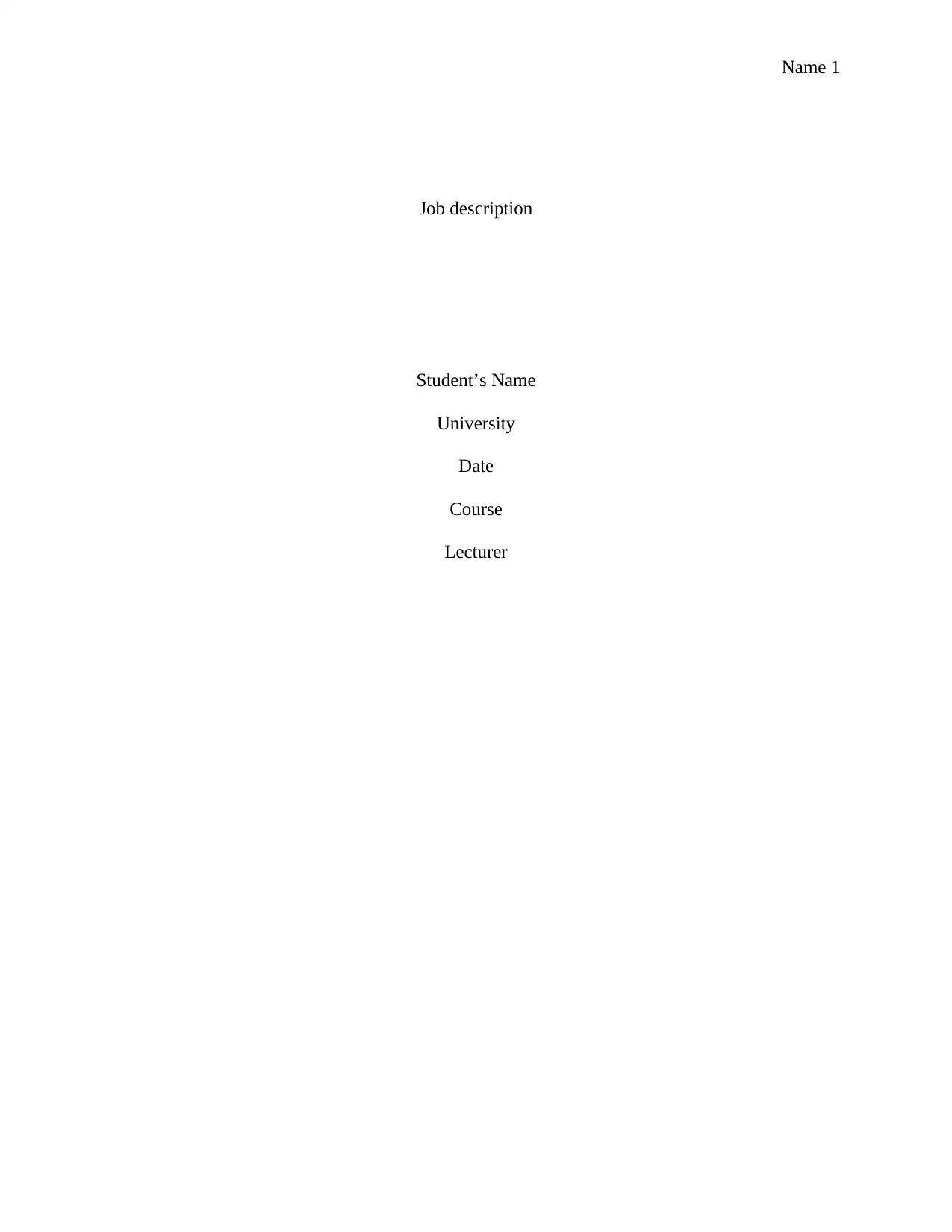
Name 1
Job description
Student’s Name
University
Date
Course
Lecturer
Job description
Student’s Name
University
Date
Course
Lecturer
Paraphrase This Document
Need a fresh take? Get an instant paraphrase of this document with our AI Paraphraser
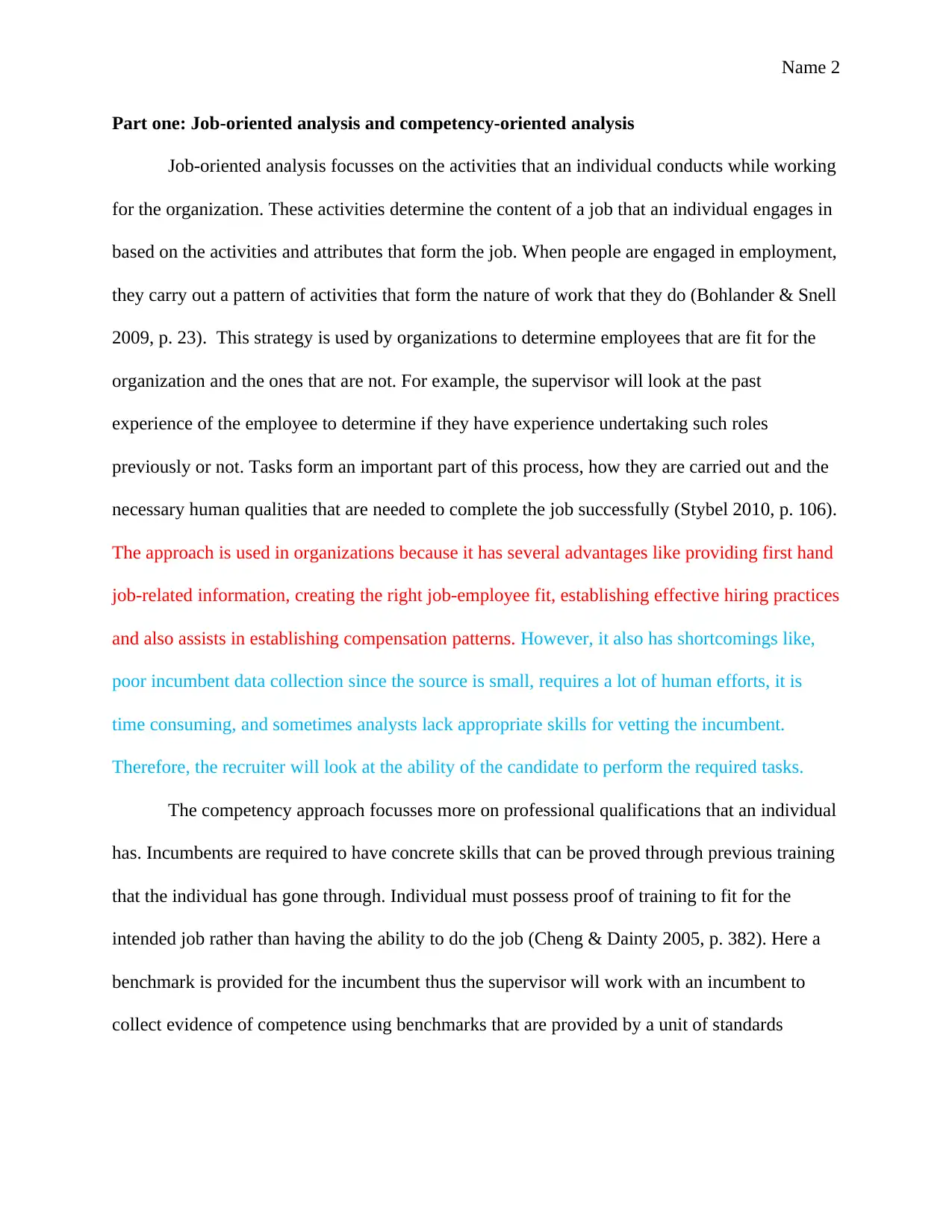
Name 2
Part one: Job-oriented analysis and competency-oriented analysis
Job-oriented analysis focusses on the activities that an individual conducts while working
for the organization. These activities determine the content of a job that an individual engages in
based on the activities and attributes that form the job. When people are engaged in employment,
they carry out a pattern of activities that form the nature of work that they do (Bohlander & Snell
2009, p. 23). This strategy is used by organizations to determine employees that are fit for the
organization and the ones that are not. For example, the supervisor will look at the past
experience of the employee to determine if they have experience undertaking such roles
previously or not. Tasks form an important part of this process, how they are carried out and the
necessary human qualities that are needed to complete the job successfully (Stybel 2010, p. 106).
The approach is used in organizations because it has several advantages like providing first hand
job-related information, creating the right job-employee fit, establishing effective hiring practices
and also assists in establishing compensation patterns. However, it also has shortcomings like,
poor incumbent data collection since the source is small, requires a lot of human efforts, it is
time consuming, and sometimes analysts lack appropriate skills for vetting the incumbent.
Therefore, the recruiter will look at the ability of the candidate to perform the required tasks.
The competency approach focusses more on professional qualifications that an individual
has. Incumbents are required to have concrete skills that can be proved through previous training
that the individual has gone through. Individual must possess proof of training to fit for the
intended job rather than having the ability to do the job (Cheng & Dainty 2005, p. 382). Here a
benchmark is provided for the incumbent thus the supervisor will work with an incumbent to
collect evidence of competence using benchmarks that are provided by a unit of standards
Part one: Job-oriented analysis and competency-oriented analysis
Job-oriented analysis focusses on the activities that an individual conducts while working
for the organization. These activities determine the content of a job that an individual engages in
based on the activities and attributes that form the job. When people are engaged in employment,
they carry out a pattern of activities that form the nature of work that they do (Bohlander & Snell
2009, p. 23). This strategy is used by organizations to determine employees that are fit for the
organization and the ones that are not. For example, the supervisor will look at the past
experience of the employee to determine if they have experience undertaking such roles
previously or not. Tasks form an important part of this process, how they are carried out and the
necessary human qualities that are needed to complete the job successfully (Stybel 2010, p. 106).
The approach is used in organizations because it has several advantages like providing first hand
job-related information, creating the right job-employee fit, establishing effective hiring practices
and also assists in establishing compensation patterns. However, it also has shortcomings like,
poor incumbent data collection since the source is small, requires a lot of human efforts, it is
time consuming, and sometimes analysts lack appropriate skills for vetting the incumbent.
Therefore, the recruiter will look at the ability of the candidate to perform the required tasks.
The competency approach focusses more on professional qualifications that an individual
has. Incumbents are required to have concrete skills that can be proved through previous training
that the individual has gone through. Individual must possess proof of training to fit for the
intended job rather than having the ability to do the job (Cheng & Dainty 2005, p. 382). Here a
benchmark is provided for the incumbent thus the supervisor will work with an incumbent to
collect evidence of competence using benchmarks that are provided by a unit of standards
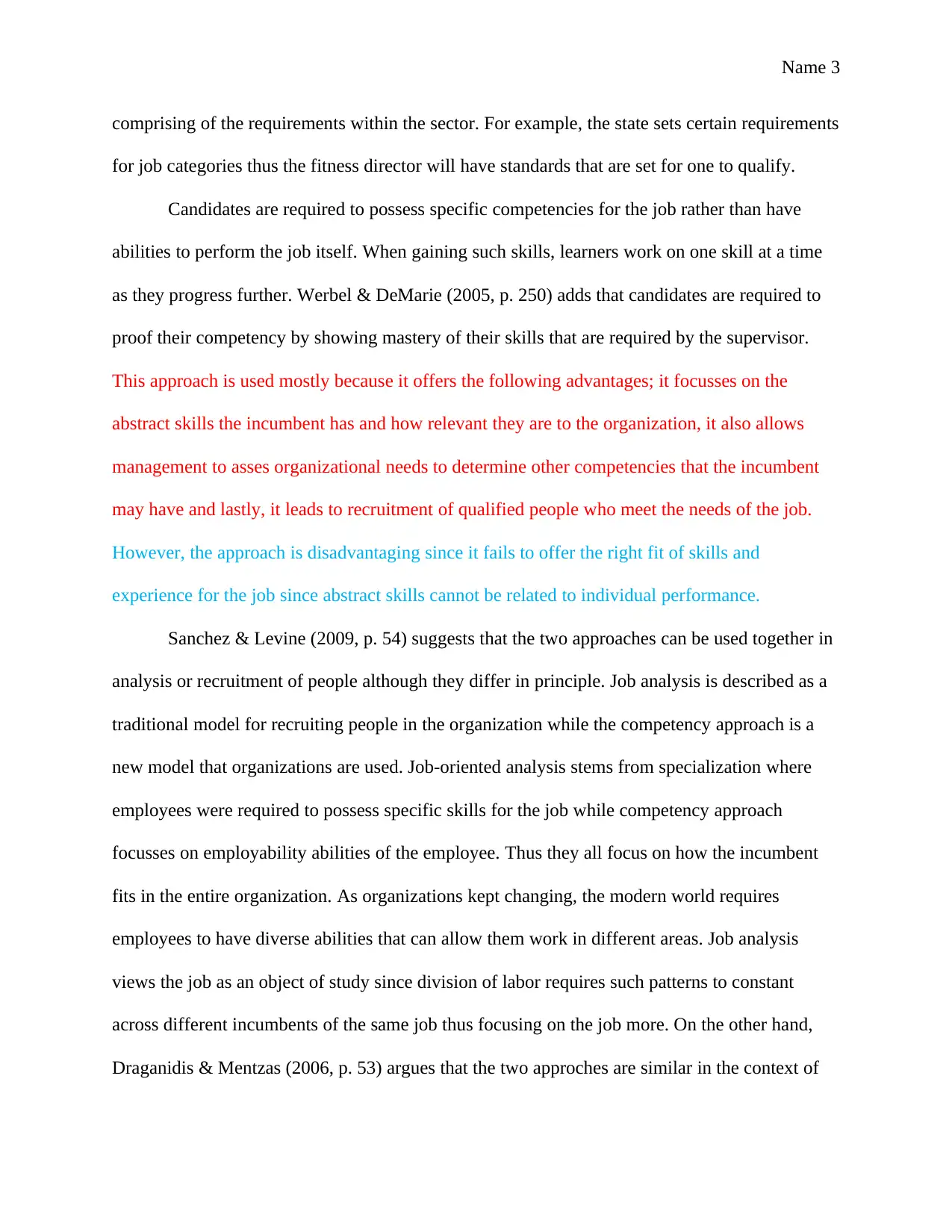
Name 3
comprising of the requirements within the sector. For example, the state sets certain requirements
for job categories thus the fitness director will have standards that are set for one to qualify.
Candidates are required to possess specific competencies for the job rather than have
abilities to perform the job itself. When gaining such skills, learners work on one skill at a time
as they progress further. Werbel & DeMarie (2005, p. 250) adds that candidates are required to
proof their competency by showing mastery of their skills that are required by the supervisor.
This approach is used mostly because it offers the following advantages; it focusses on the
abstract skills the incumbent has and how relevant they are to the organization, it also allows
management to asses organizational needs to determine other competencies that the incumbent
may have and lastly, it leads to recruitment of qualified people who meet the needs of the job.
However, the approach is disadvantaging since it fails to offer the right fit of skills and
experience for the job since abstract skills cannot be related to individual performance.
Sanchez & Levine (2009, p. 54) suggests that the two approaches can be used together in
analysis or recruitment of people although they differ in principle. Job analysis is described as a
traditional model for recruiting people in the organization while the competency approach is a
new model that organizations are used. Job-oriented analysis stems from specialization where
employees were required to possess specific skills for the job while competency approach
focusses on employability abilities of the employee. Thus they all focus on how the incumbent
fits in the entire organization. As organizations kept changing, the modern world requires
employees to have diverse abilities that can allow them work in different areas. Job analysis
views the job as an object of study since division of labor requires such patterns to constant
across different incumbents of the same job thus focusing on the job more. On the other hand,
Draganidis & Mentzas (2006, p. 53) argues that the two approches are similar in the context of
comprising of the requirements within the sector. For example, the state sets certain requirements
for job categories thus the fitness director will have standards that are set for one to qualify.
Candidates are required to possess specific competencies for the job rather than have
abilities to perform the job itself. When gaining such skills, learners work on one skill at a time
as they progress further. Werbel & DeMarie (2005, p. 250) adds that candidates are required to
proof their competency by showing mastery of their skills that are required by the supervisor.
This approach is used mostly because it offers the following advantages; it focusses on the
abstract skills the incumbent has and how relevant they are to the organization, it also allows
management to asses organizational needs to determine other competencies that the incumbent
may have and lastly, it leads to recruitment of qualified people who meet the needs of the job.
However, the approach is disadvantaging since it fails to offer the right fit of skills and
experience for the job since abstract skills cannot be related to individual performance.
Sanchez & Levine (2009, p. 54) suggests that the two approaches can be used together in
analysis or recruitment of people although they differ in principle. Job analysis is described as a
traditional model for recruiting people in the organization while the competency approach is a
new model that organizations are used. Job-oriented analysis stems from specialization where
employees were required to possess specific skills for the job while competency approach
focusses on employability abilities of the employee. Thus they all focus on how the incumbent
fits in the entire organization. As organizations kept changing, the modern world requires
employees to have diverse abilities that can allow them work in different areas. Job analysis
views the job as an object of study since division of labor requires such patterns to constant
across different incumbents of the same job thus focusing on the job more. On the other hand,
Draganidis & Mentzas (2006, p. 53) argues that the two approches are similar in the context of
⊘ This is a preview!⊘
Do you want full access?
Subscribe today to unlock all pages.

Trusted by 1+ million students worldwide
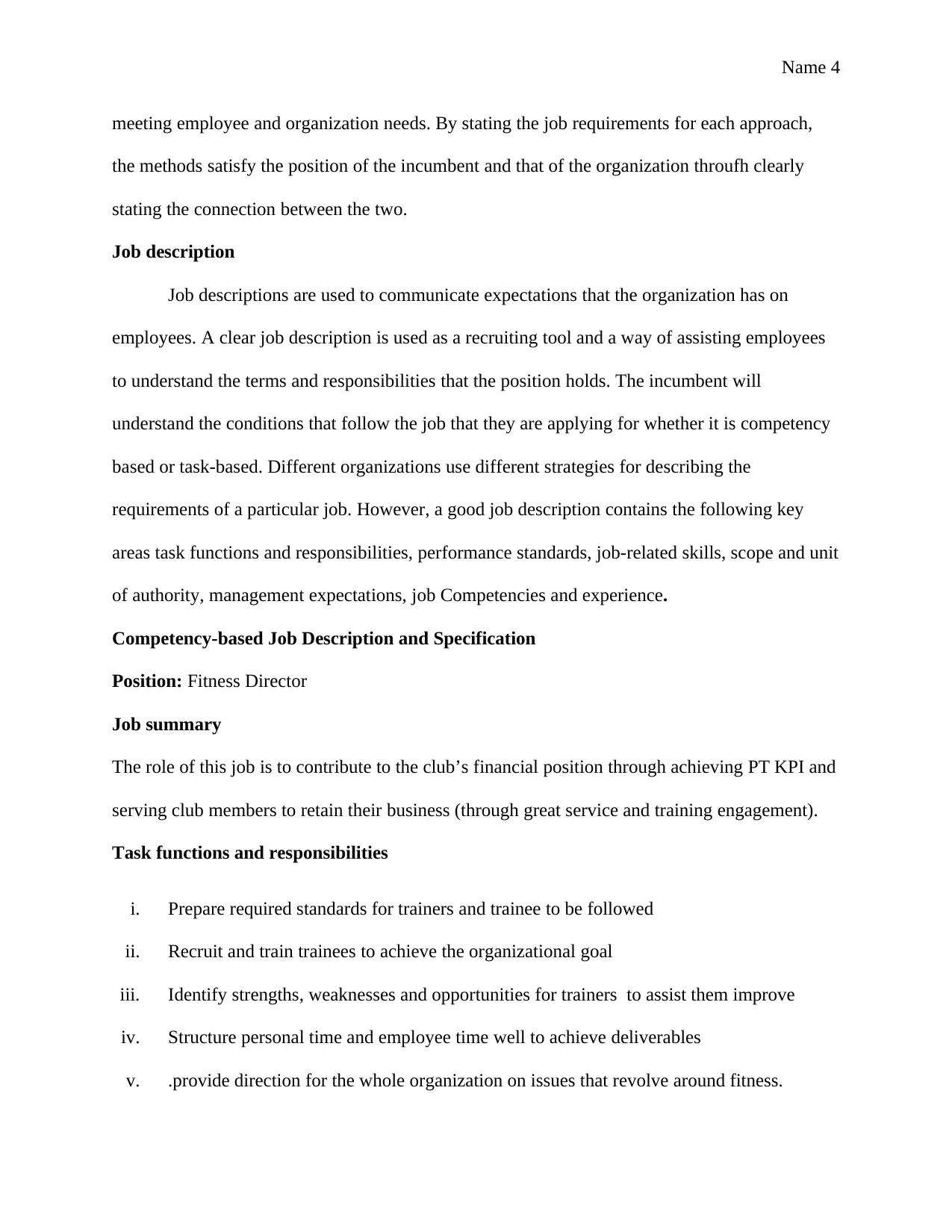
Name 4
meeting employee and organization needs. By stating the job requirements for each approach,
the methods satisfy the position of the incumbent and that of the organization throufh clearly
stating the connection between the two.
Job description
Job descriptions are used to communicate expectations that the organization has on
employees. A clear job description is used as a recruiting tool and a way of assisting employees
to understand the terms and responsibilities that the position holds. The incumbent will
understand the conditions that follow the job that they are applying for whether it is competency
based or task-based. Different organizations use different strategies for describing the
requirements of a particular job. However, a good job description contains the following key
areas task functions and responsibilities, performance standards, job-related skills, scope and unit
of authority, management expectations, job Competencies and experience.
Competency-based Job Description and Specification
Position: Fitness Director
Job summary
The role of this job is to contribute to the club’s financial position through achieving PT KPI and
serving club members to retain their business (through great service and training engagement).
Task functions and responsibilities
i. Prepare required standards for trainers and trainee to be followed
ii. Recruit and train trainees to achieve the organizational goal
iii. Identify strengths, weaknesses and opportunities for trainers to assist them improve
iv. Structure personal time and employee time well to achieve deliverables
v. .provide direction for the whole organization on issues that revolve around fitness.
meeting employee and organization needs. By stating the job requirements for each approach,
the methods satisfy the position of the incumbent and that of the organization throufh clearly
stating the connection between the two.
Job description
Job descriptions are used to communicate expectations that the organization has on
employees. A clear job description is used as a recruiting tool and a way of assisting employees
to understand the terms and responsibilities that the position holds. The incumbent will
understand the conditions that follow the job that they are applying for whether it is competency
based or task-based. Different organizations use different strategies for describing the
requirements of a particular job. However, a good job description contains the following key
areas task functions and responsibilities, performance standards, job-related skills, scope and unit
of authority, management expectations, job Competencies and experience.
Competency-based Job Description and Specification
Position: Fitness Director
Job summary
The role of this job is to contribute to the club’s financial position through achieving PT KPI and
serving club members to retain their business (through great service and training engagement).
Task functions and responsibilities
i. Prepare required standards for trainers and trainee to be followed
ii. Recruit and train trainees to achieve the organizational goal
iii. Identify strengths, weaknesses and opportunities for trainers to assist them improve
iv. Structure personal time and employee time well to achieve deliverables
v. .provide direction for the whole organization on issues that revolve around fitness.
Paraphrase This Document
Need a fresh take? Get an instant paraphrase of this document with our AI Paraphraser
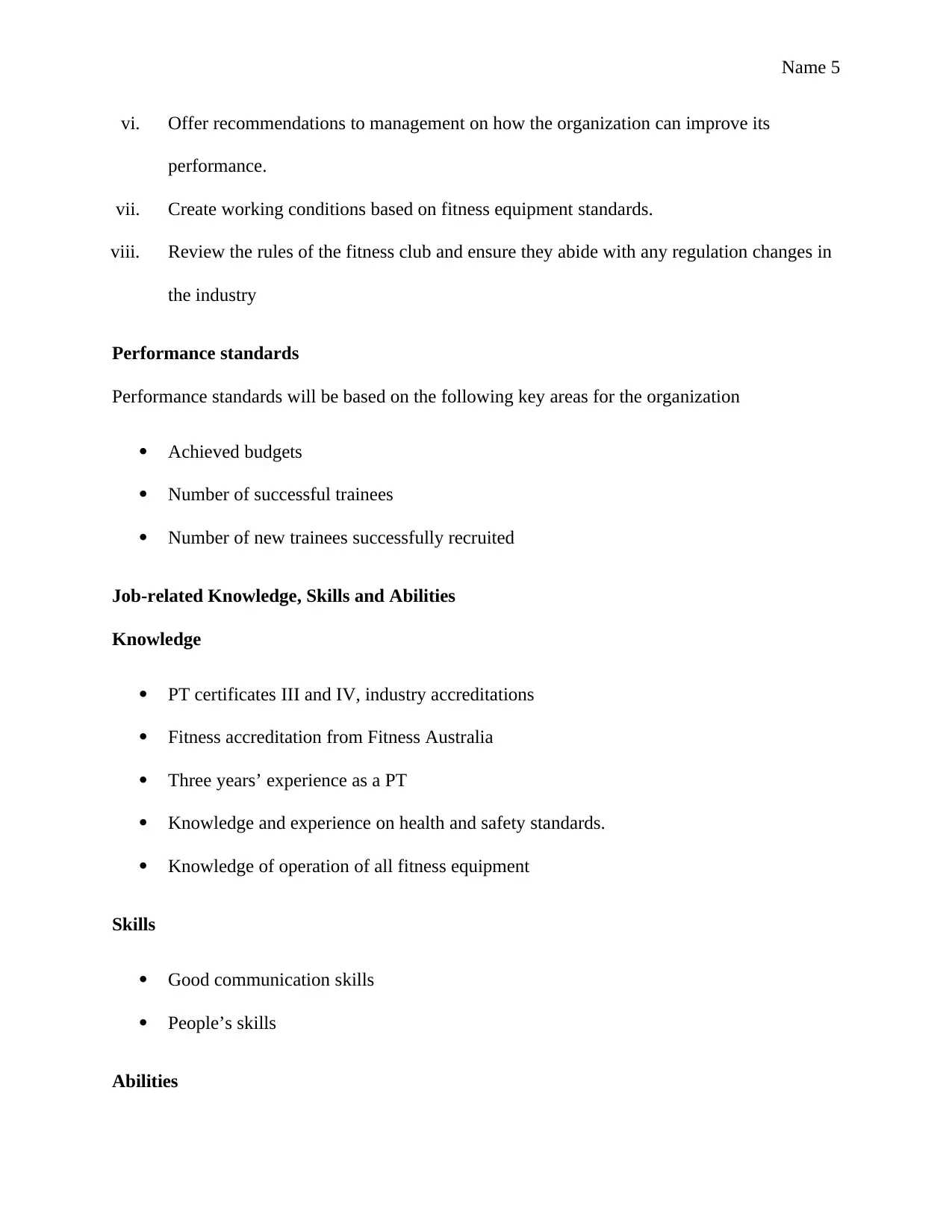
Name 5
vi. Offer recommendations to management on how the organization can improve its
performance.
vii. Create working conditions based on fitness equipment standards.
viii. Review the rules of the fitness club and ensure they abide with any regulation changes in
the industry
Performance standards
Performance standards will be based on the following key areas for the organization
Achieved budgets
Number of successful trainees
Number of new trainees successfully recruited
Job-related Knowledge, Skills and Abilities
Knowledge
PT certificates III and IV, industry accreditations
Fitness accreditation from Fitness Australia
Three years’ experience as a PT
Knowledge and experience on health and safety standards.
Knowledge of operation of all fitness equipment
Skills
Good communication skills
People’s skills
Abilities
vi. Offer recommendations to management on how the organization can improve its
performance.
vii. Create working conditions based on fitness equipment standards.
viii. Review the rules of the fitness club and ensure they abide with any regulation changes in
the industry
Performance standards
Performance standards will be based on the following key areas for the organization
Achieved budgets
Number of successful trainees
Number of new trainees successfully recruited
Job-related Knowledge, Skills and Abilities
Knowledge
PT certificates III and IV, industry accreditations
Fitness accreditation from Fitness Australia
Three years’ experience as a PT
Knowledge and experience on health and safety standards.
Knowledge of operation of all fitness equipment
Skills
Good communication skills
People’s skills
Abilities
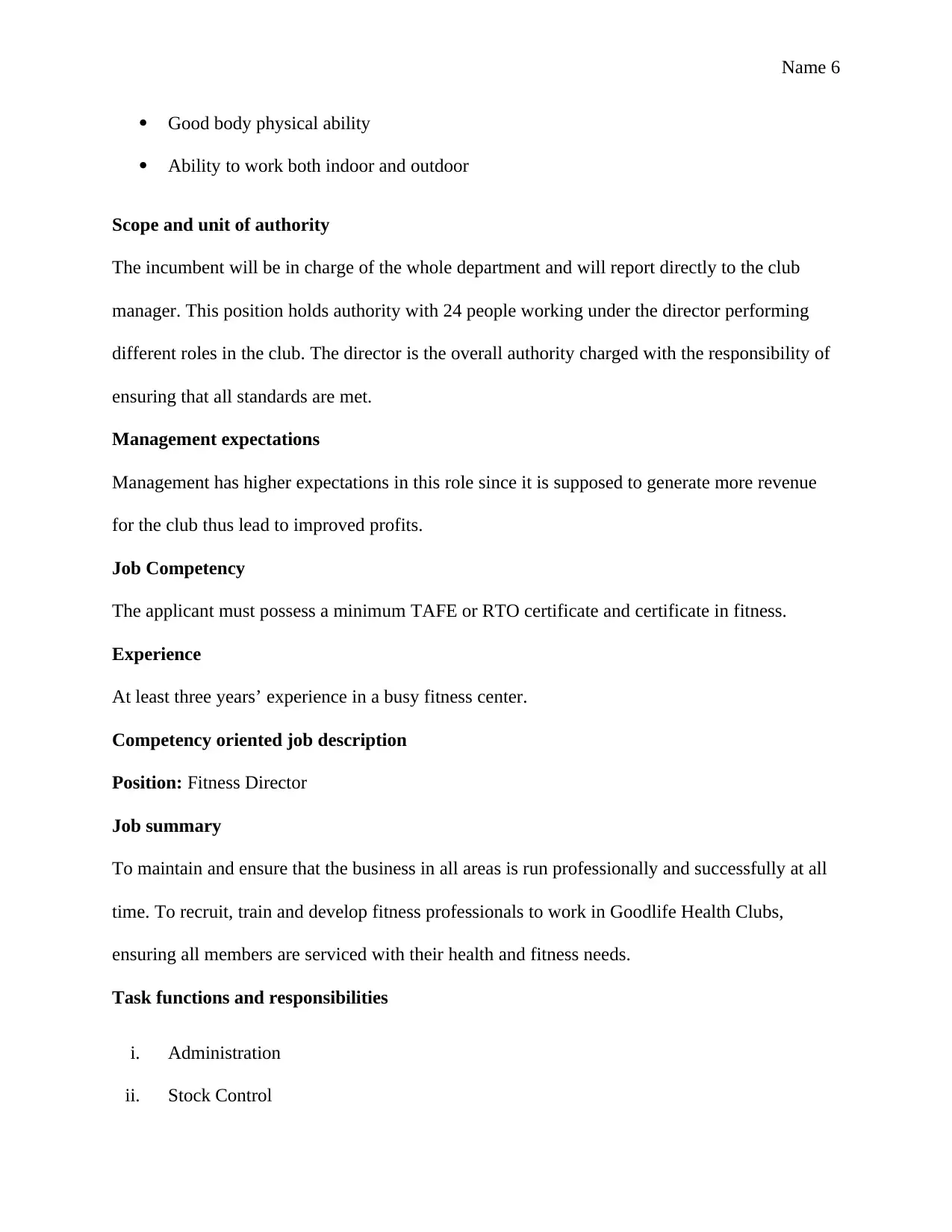
Name 6
Good body physical ability
Ability to work both indoor and outdoor
Scope and unit of authority
The incumbent will be in charge of the whole department and will report directly to the club
manager. This position holds authority with 24 people working under the director performing
different roles in the club. The director is the overall authority charged with the responsibility of
ensuring that all standards are met.
Management expectations
Management has higher expectations in this role since it is supposed to generate more revenue
for the club thus lead to improved profits.
Job Competency
The applicant must possess a minimum TAFE or RTO certificate and certificate in fitness.
Experience
At least three years’ experience in a busy fitness center.
Competency oriented job description
Position: Fitness Director
Job summary
To maintain and ensure that the business in all areas is run professionally and successfully at all
time. To recruit, train and develop fitness professionals to work in Goodlife Health Clubs,
ensuring all members are serviced with their health and fitness needs.
Task functions and responsibilities
i. Administration
ii. Stock Control
Good body physical ability
Ability to work both indoor and outdoor
Scope and unit of authority
The incumbent will be in charge of the whole department and will report directly to the club
manager. This position holds authority with 24 people working under the director performing
different roles in the club. The director is the overall authority charged with the responsibility of
ensuring that all standards are met.
Management expectations
Management has higher expectations in this role since it is supposed to generate more revenue
for the club thus lead to improved profits.
Job Competency
The applicant must possess a minimum TAFE or RTO certificate and certificate in fitness.
Experience
At least three years’ experience in a busy fitness center.
Competency oriented job description
Position: Fitness Director
Job summary
To maintain and ensure that the business in all areas is run professionally and successfully at all
time. To recruit, train and develop fitness professionals to work in Goodlife Health Clubs,
ensuring all members are serviced with their health and fitness needs.
Task functions and responsibilities
i. Administration
ii. Stock Control
⊘ This is a preview!⊘
Do you want full access?
Subscribe today to unlock all pages.

Trusted by 1+ million students worldwide
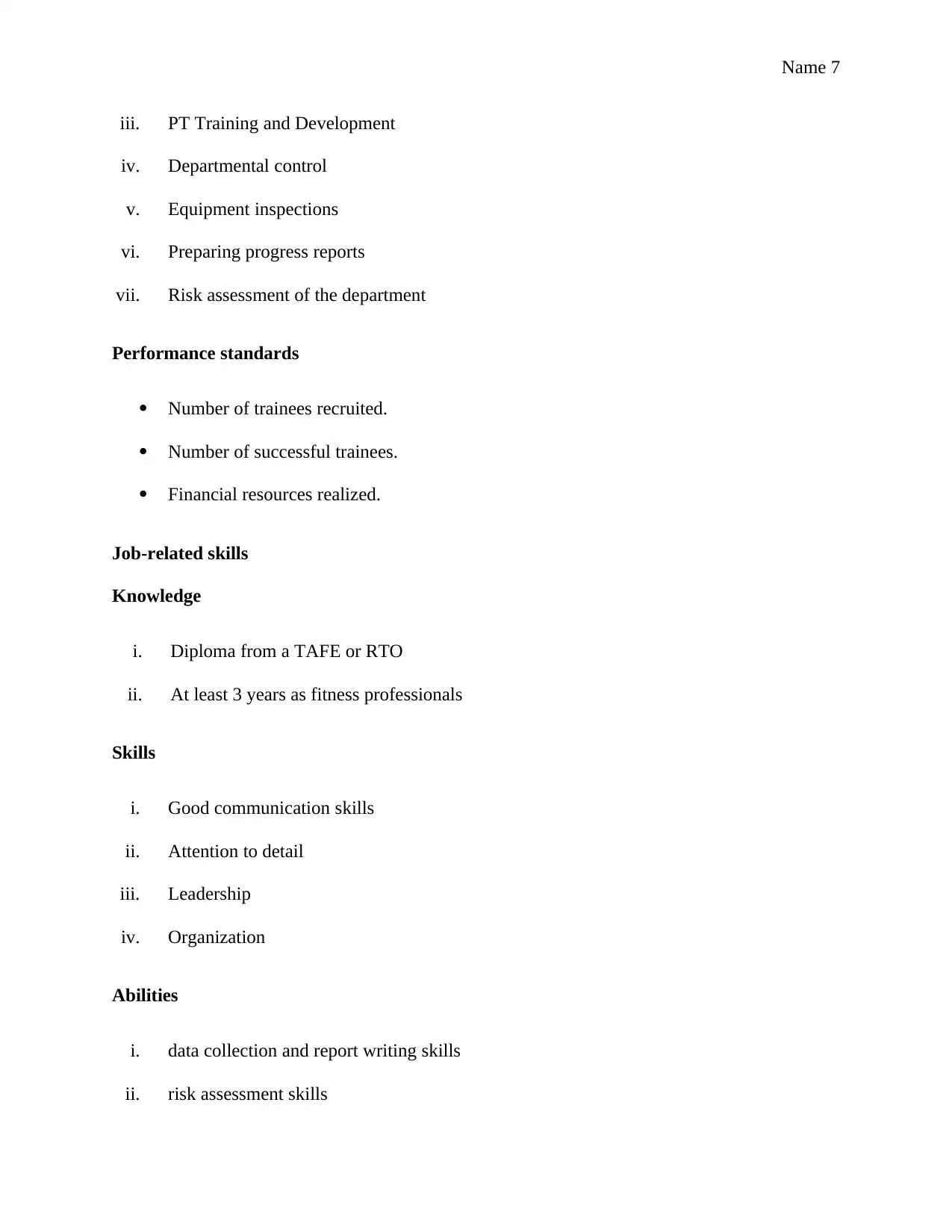
Name 7
iii. PT Training and Development
iv. Departmental control
v. Equipment inspections
vi. Preparing progress reports
vii. Risk assessment of the department
Performance standards
Number of trainees recruited.
Number of successful trainees.
Financial resources realized.
Job-related skills
Knowledge
i. Diploma from a TAFE or RTO
ii. At least 3 years as fitness professionals
Skills
i. Good communication skills
ii. Attention to detail
iii. Leadership
iv. Organization
Abilities
i. data collection and report writing skills
ii. risk assessment skills
iii. PT Training and Development
iv. Departmental control
v. Equipment inspections
vi. Preparing progress reports
vii. Risk assessment of the department
Performance standards
Number of trainees recruited.
Number of successful trainees.
Financial resources realized.
Job-related skills
Knowledge
i. Diploma from a TAFE or RTO
ii. At least 3 years as fitness professionals
Skills
i. Good communication skills
ii. Attention to detail
iii. Leadership
iv. Organization
Abilities
i. data collection and report writing skills
ii. risk assessment skills
Paraphrase This Document
Need a fresh take? Get an instant paraphrase of this document with our AI Paraphraser
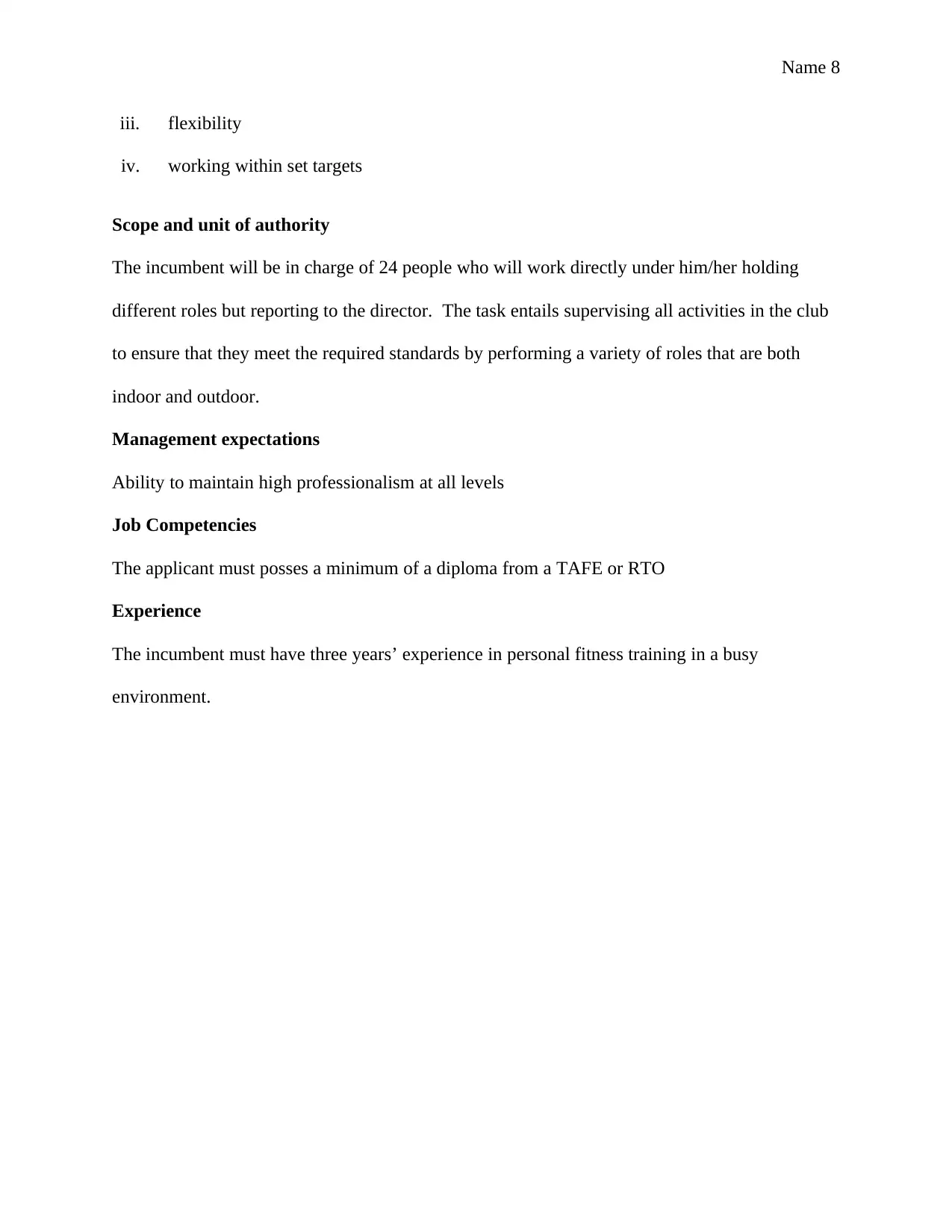
Name 8
iii. flexibility
iv. working within set targets
Scope and unit of authority
The incumbent will be in charge of 24 people who will work directly under him/her holding
different roles but reporting to the director. The task entails supervising all activities in the club
to ensure that they meet the required standards by performing a variety of roles that are both
indoor and outdoor.
Management expectations
Ability to maintain high professionalism at all levels
Job Competencies
The applicant must posses a minimum of a diploma from a TAFE or RTO
Experience
The incumbent must have three years’ experience in personal fitness training in a busy
environment.
iii. flexibility
iv. working within set targets
Scope and unit of authority
The incumbent will be in charge of 24 people who will work directly under him/her holding
different roles but reporting to the director. The task entails supervising all activities in the club
to ensure that they meet the required standards by performing a variety of roles that are both
indoor and outdoor.
Management expectations
Ability to maintain high professionalism at all levels
Job Competencies
The applicant must posses a minimum of a diploma from a TAFE or RTO
Experience
The incumbent must have three years’ experience in personal fitness training in a busy
environment.
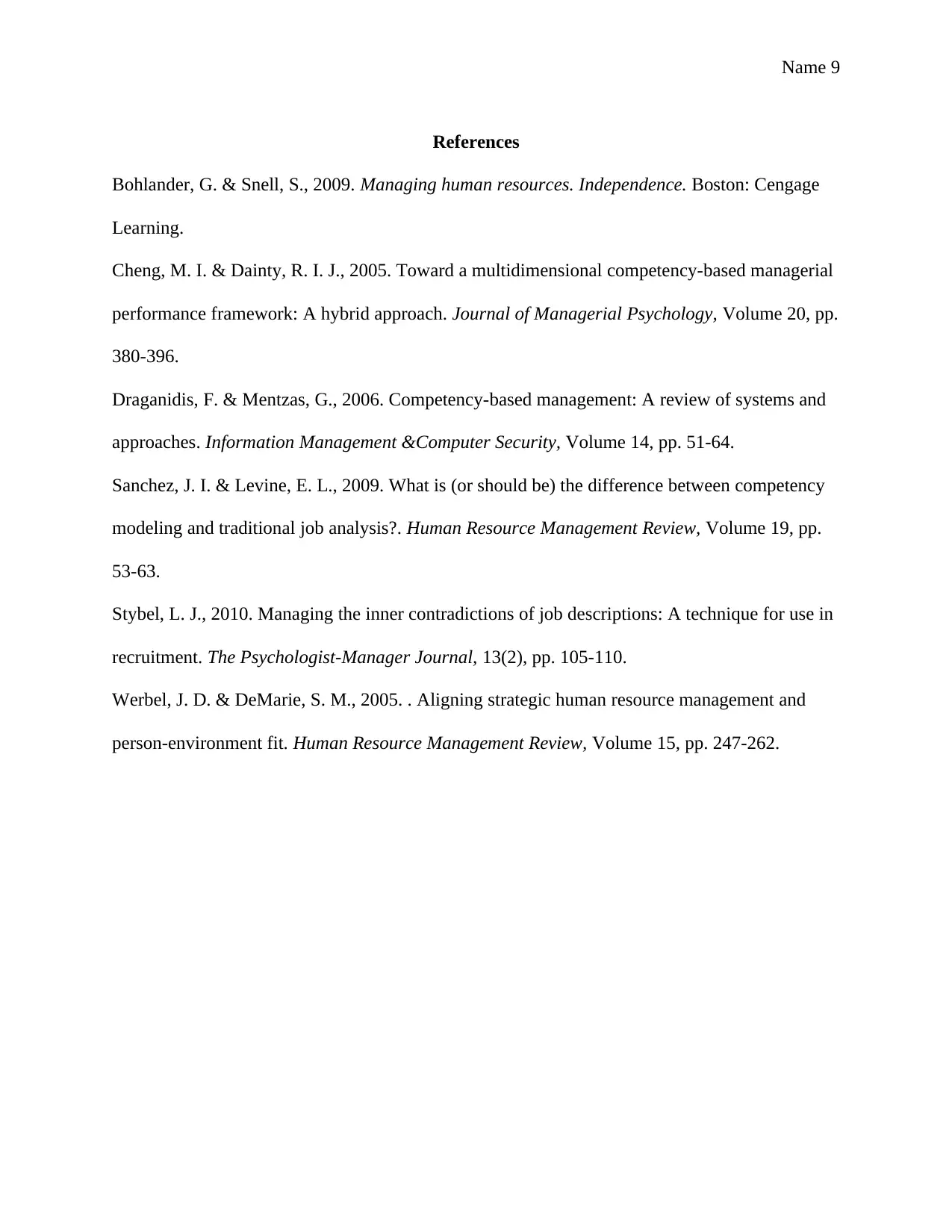
Name 9
References
Bohlander, G. & Snell, S., 2009. Managing human resources. Independence. Boston: Cengage
Learning.
Cheng, M. I. & Dainty, R. I. J., 2005. Toward a multidimensional competency-based managerial
performance framework: A hybrid approach. Journal of Managerial Psychology, Volume 20, pp.
380-396.
Draganidis, F. & Mentzas, G., 2006. Competency-based management: A review of systems and
approaches. Information Management &Computer Security, Volume 14, pp. 51-64.
Sanchez, J. I. & Levine, E. L., 2009. What is (or should be) the difference between competency
modeling and traditional job analysis?. Human Resource Management Review, Volume 19, pp.
53-63.
Stybel, L. J., 2010. Managing the inner contradictions of job descriptions: A technique for use in
recruitment. The Psychologist-Manager Journal, 13(2), pp. 105-110.
Werbel, J. D. & DeMarie, S. M., 2005. . Aligning strategic human resource management and
person-environment fit. Human Resource Management Review, Volume 15, pp. 247-262.
References
Bohlander, G. & Snell, S., 2009. Managing human resources. Independence. Boston: Cengage
Learning.
Cheng, M. I. & Dainty, R. I. J., 2005. Toward a multidimensional competency-based managerial
performance framework: A hybrid approach. Journal of Managerial Psychology, Volume 20, pp.
380-396.
Draganidis, F. & Mentzas, G., 2006. Competency-based management: A review of systems and
approaches. Information Management &Computer Security, Volume 14, pp. 51-64.
Sanchez, J. I. & Levine, E. L., 2009. What is (or should be) the difference between competency
modeling and traditional job analysis?. Human Resource Management Review, Volume 19, pp.
53-63.
Stybel, L. J., 2010. Managing the inner contradictions of job descriptions: A technique for use in
recruitment. The Psychologist-Manager Journal, 13(2), pp. 105-110.
Werbel, J. D. & DeMarie, S. M., 2005. . Aligning strategic human resource management and
person-environment fit. Human Resource Management Review, Volume 15, pp. 247-262.
⊘ This is a preview!⊘
Do you want full access?
Subscribe today to unlock all pages.

Trusted by 1+ million students worldwide
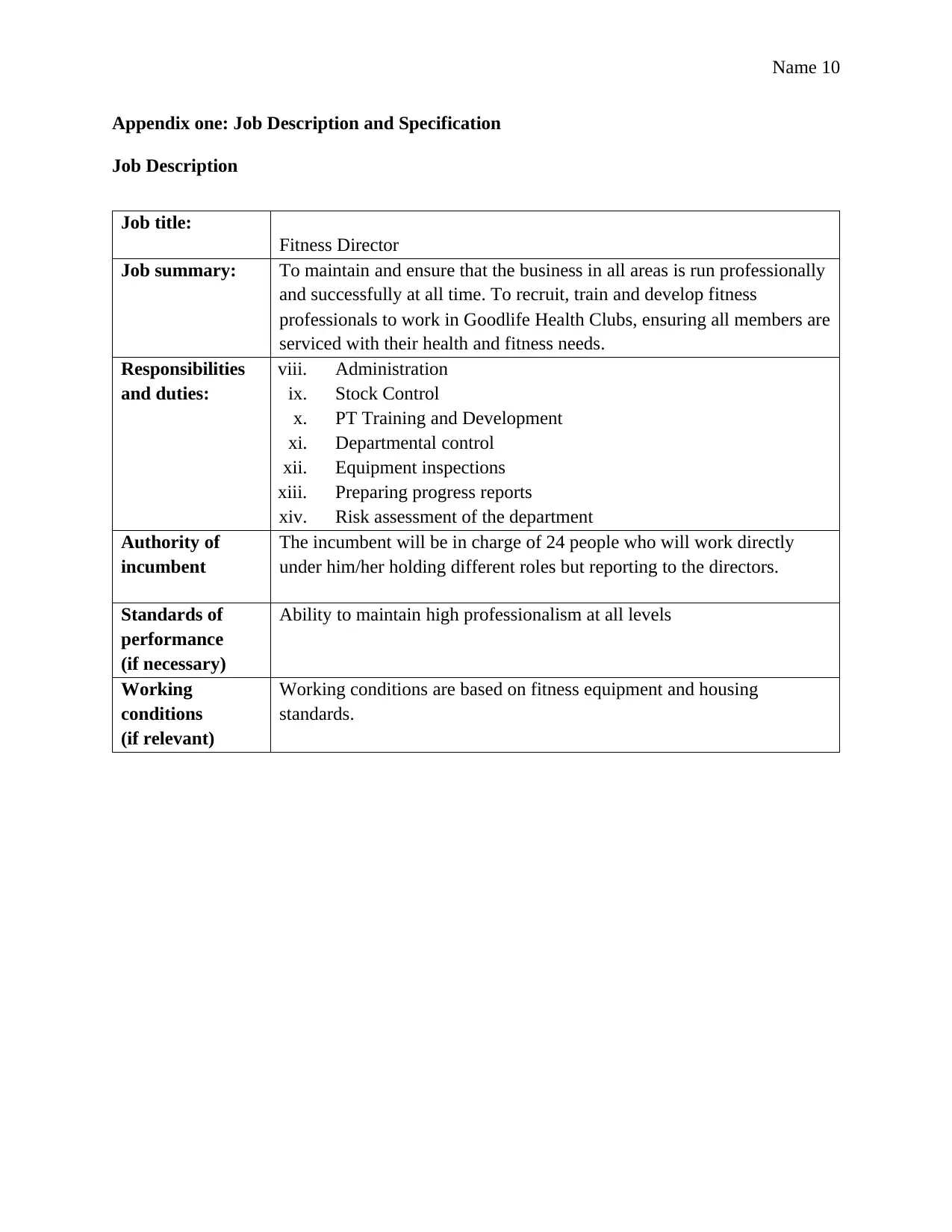
Name 10
Appendix one: Job Description and Specification
Job Description
Job title:
Fitness Director
Job summary: To maintain and ensure that the business in all areas is run professionally
and successfully at all time. To recruit, train and develop fitness
professionals to work in Goodlife Health Clubs, ensuring all members are
serviced with their health and fitness needs.
Responsibilities
and duties:
viii. Administration
ix. Stock Control
x. PT Training and Development
xi. Departmental control
xii. Equipment inspections
xiii. Preparing progress reports
xiv. Risk assessment of the department
Authority of
incumbent
The incumbent will be in charge of 24 people who will work directly
under him/her holding different roles but reporting to the directors.
Standards of
performance
(if necessary)
Ability to maintain high professionalism at all levels
Working
conditions
(if relevant)
Working conditions are based on fitness equipment and housing
standards.
Appendix one: Job Description and Specification
Job Description
Job title:
Fitness Director
Job summary: To maintain and ensure that the business in all areas is run professionally
and successfully at all time. To recruit, train and develop fitness
professionals to work in Goodlife Health Clubs, ensuring all members are
serviced with their health and fitness needs.
Responsibilities
and duties:
viii. Administration
ix. Stock Control
x. PT Training and Development
xi. Departmental control
xii. Equipment inspections
xiii. Preparing progress reports
xiv. Risk assessment of the department
Authority of
incumbent
The incumbent will be in charge of 24 people who will work directly
under him/her holding different roles but reporting to the directors.
Standards of
performance
(if necessary)
Ability to maintain high professionalism at all levels
Working
conditions
(if relevant)
Working conditions are based on fitness equipment and housing
standards.
Paraphrase This Document
Need a fresh take? Get an instant paraphrase of this document with our AI Paraphraser
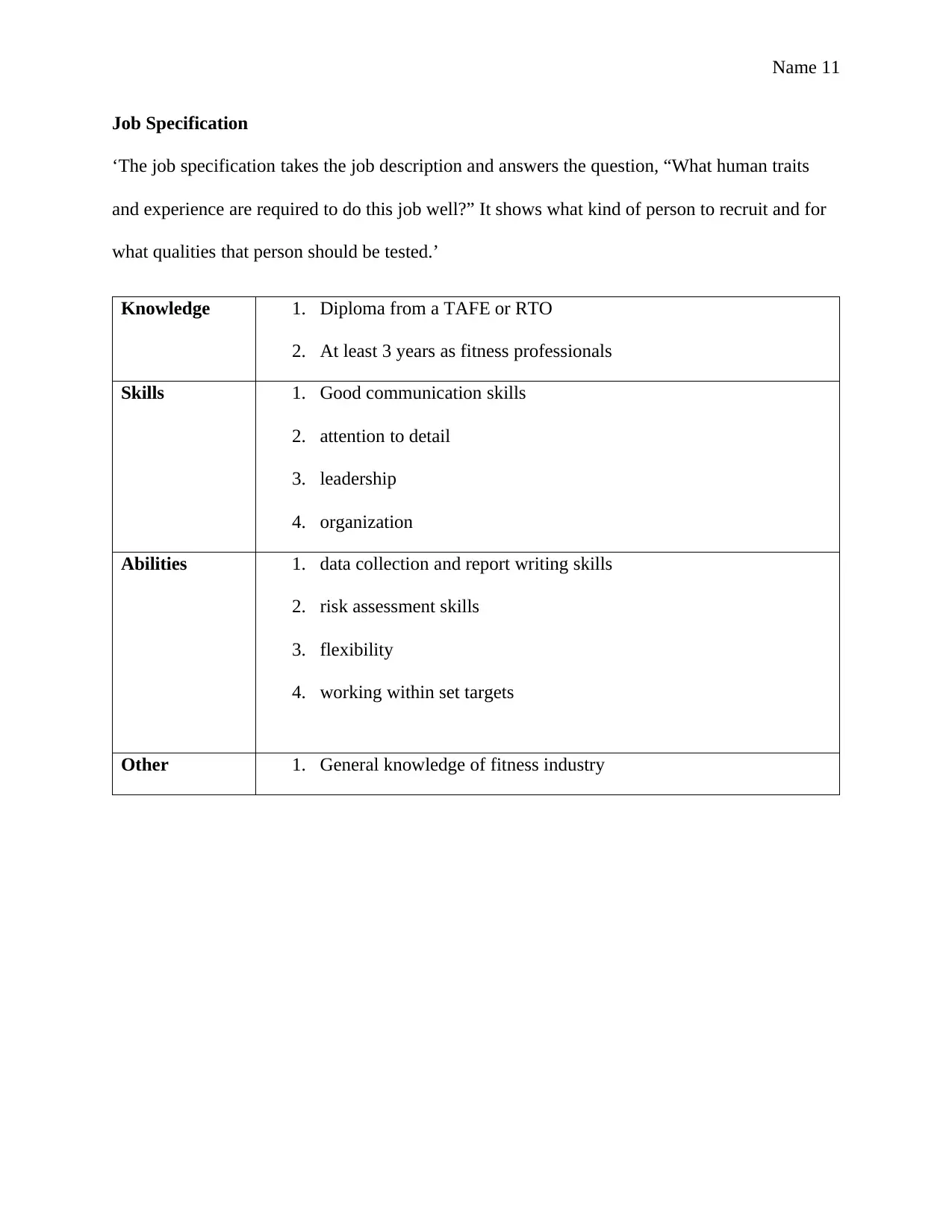
Name 11
Job Specification
‘The job specification takes the job description and answers the question, “What human traits
and experience are required to do this job well?” It shows what kind of person to recruit and for
what qualities that person should be tested.’
Knowledge 1. Diploma from a TAFE or RTO
2. At least 3 years as fitness professionals
Skills 1. Good communication skills
2. attention to detail
3. leadership
4. organization
Abilities 1. data collection and report writing skills
2. risk assessment skills
3. flexibility
4. working within set targets
Other 1. General knowledge of fitness industry
Job Specification
‘The job specification takes the job description and answers the question, “What human traits
and experience are required to do this job well?” It shows what kind of person to recruit and for
what qualities that person should be tested.’
Knowledge 1. Diploma from a TAFE or RTO
2. At least 3 years as fitness professionals
Skills 1. Good communication skills
2. attention to detail
3. leadership
4. organization
Abilities 1. data collection and report writing skills
2. risk assessment skills
3. flexibility
4. working within set targets
Other 1. General knowledge of fitness industry
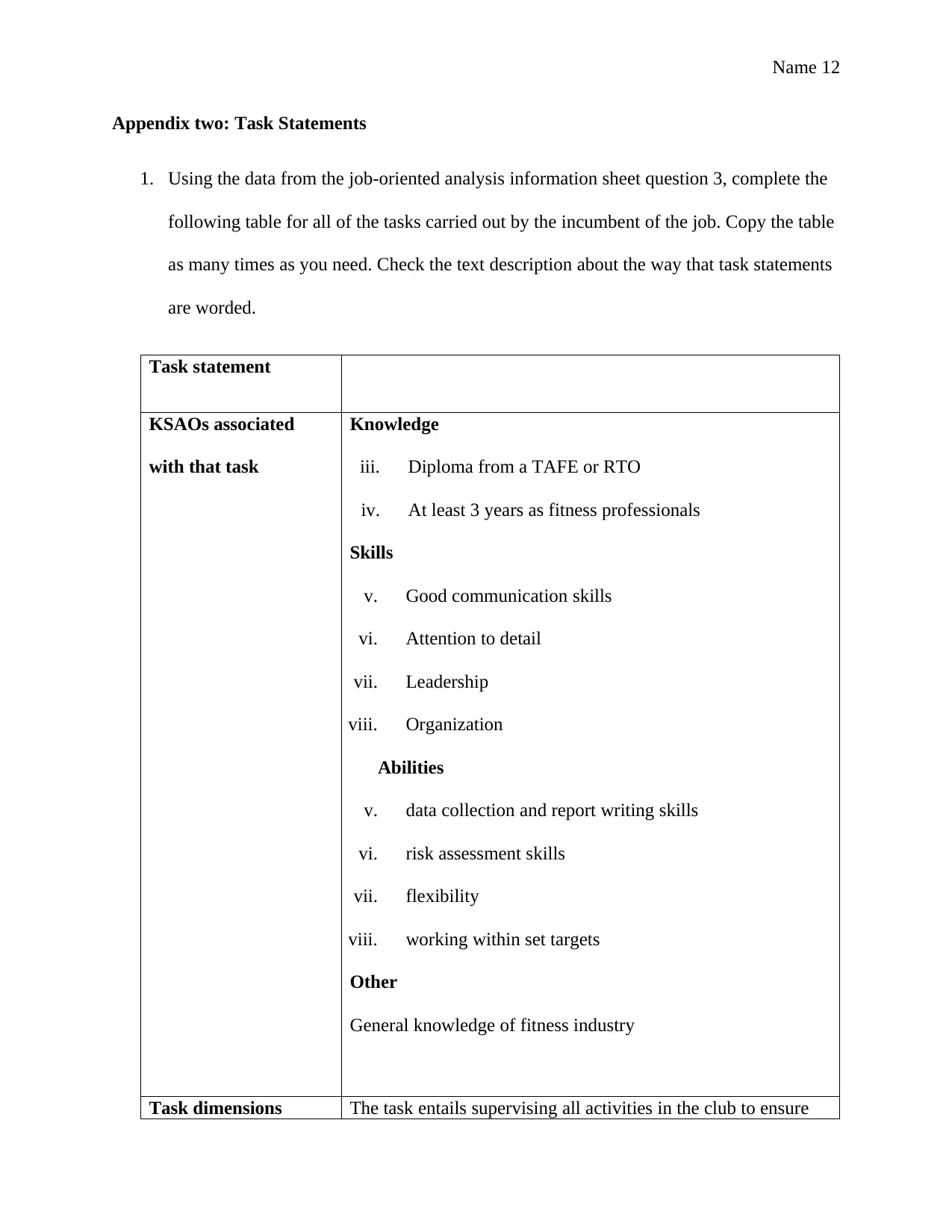
Name 12
Appendix two: Task Statements
1. Using the data from the job-oriented analysis information sheet question 3, complete the
following table for all of the tasks carried out by the incumbent of the job. Copy the table
as many times as you need. Check the text description about the way that task statements
are worded.
Task statement
KSAOs associated
with that task
Knowledge
iii. Diploma from a TAFE or RTO
iv. At least 3 years as fitness professionals
Skills
v. Good communication skills
vi. Attention to detail
vii. Leadership
viii. Organization
Abilities
v. data collection and report writing skills
vi. risk assessment skills
vii. flexibility
viii. working within set targets
Other
General knowledge of fitness industry
Task dimensions The task entails supervising all activities in the club to ensure
Appendix two: Task Statements
1. Using the data from the job-oriented analysis information sheet question 3, complete the
following table for all of the tasks carried out by the incumbent of the job. Copy the table
as many times as you need. Check the text description about the way that task statements
are worded.
Task statement
KSAOs associated
with that task
Knowledge
iii. Diploma from a TAFE or RTO
iv. At least 3 years as fitness professionals
Skills
v. Good communication skills
vi. Attention to detail
vii. Leadership
viii. Organization
Abilities
v. data collection and report writing skills
vi. risk assessment skills
vii. flexibility
viii. working within set targets
Other
General knowledge of fitness industry
Task dimensions The task entails supervising all activities in the club to ensure
⊘ This is a preview!⊘
Do you want full access?
Subscribe today to unlock all pages.

Trusted by 1+ million students worldwide
1 out of 20
Related Documents
Your All-in-One AI-Powered Toolkit for Academic Success.
+13062052269
info@desklib.com
Available 24*7 on WhatsApp / Email
![[object Object]](/_next/static/media/star-bottom.7253800d.svg)
Unlock your academic potential
Copyright © 2020–2025 A2Z Services. All Rights Reserved. Developed and managed by ZUCOL.





